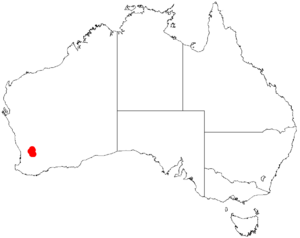Tangle wattle facts for kids
Quick facts for kids Tangle wattle |
|
|---|---|
| Conservation status | |
| Scientific classification | |
| Genus: |
Acacia
|
| Species: |
volubilis
|
 |
|
| Occurrence data from AVH | |
The Tangle Wattle (scientific name: Acacia volubilis) is a special kind of shrub. It's known for its twisted, tangled branches, which is why it's called "tangle wattle"! This plant is native to a small area in Western Australia. Sadly, it's considered endangered, meaning there aren't many left in the wild.
Contents
What the Tangle Wattle Looks Like
This shrub is quite dense and rounded, like a compact bush. It usually grows to be about 0.3 to 0.4 meters (about 1 foot) tall and can spread out to 1 meter (about 3 feet) wide.
Its branches are very unique. They look twisted and have parallel lines running along them. The plant's "leaves," which are actually called phyllodes (they look like leaves but are part of the stem), are spaced far apart. Each phyllode is small, about 9 millimeters (0.35 inches) long and 1 millimeter (0.04 inches) wide. They have the same twisted shape as the branches.
In June and July, the Tangle Wattle blooms with bright yellow flowers. These flowers grow in round, ball-shaped clusters called inflorescences.
Naming the Tangle Wattle
The Tangle Wattle was first officially described by a botanist named Ferdinand von Mueller in 1877. He wrote about it in his work called Fragmenta Phytographiae Australiae.
The scientific name volubilis comes from a Latin word that means "twining" or "twisting." This name perfectly describes how the plant's branches grow in a tangled, twisted way.
Where the Tangle Wattle Lives
You can find the Tangle Wattle in a small area of Western Australia. This area is located between the towns of Cunderdin, Quairading, and Tammin.
It likes to grow in sandy or clay soils that have gravel in them. You might spot it along the sides of roads or in areas with other shrubs, especially where there's laterite or granite rock. It often grows near other plants like different types of Allocasuarina, Acacia, Grevillea, Actinostrobus, and Hakea.
For a while, people thought the Tangle Wattle had completely disappeared. But in 1996, a botanist named Brenden Lepschi found a small group of these plants near Cunderdin! After that, more small groups were discovered.
Because each group of plants was tiny and in great danger, the Tangle Wattle was officially declared "Rare Flora" in October 1996. Then, in December 1997, it was listed as "Critically Endangered," meaning it was at very high risk of disappearing forever. By 2003, only 88 Tangle Wattle plants were known to exist, spread across 12 different locations.
See also
 In Spanish: Acacia volubilis para niños
In Spanish: Acacia volubilis para niños


